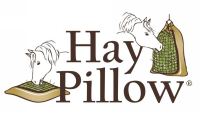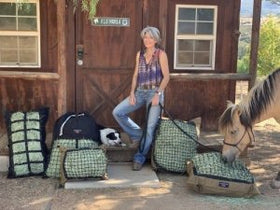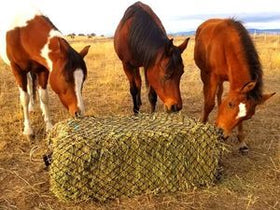We promote slow fed, free-choice hay (forage) with multiple locations to encourage movement. Why? Because movement and access to forage are crucial elements necessary for a happier and healthier horse! And together, they help manage weight.
Horses are designed to graze/forage 16-20 hours a day - ingesting small amounts as they move from place to place. It is possible to mimic the horse's natural lifestyle – to allow free choice forage and slow consumption, while encouraging movement – in almost any environment and weather condition. The mental, emotional and physical benefits of a more natural lifestyle are numerous.
We hope the following tips for introducing and incorporating free-choice forage help you achieve a more natural lifestyle for your horse or herd.
Horses are designed to graze/forage 16-20 hours a day - ingesting small amounts as they move from place to place. It is possible to mimic the horse's natural lifestyle – to allow free choice forage and slow consumption, while encouraging movement – in almost any environment and weather condition. The mental, emotional and physical benefits of a more natural lifestyle are numerous.
We hope the following tips for introducing and incorporating free-choice forage help you achieve a more natural lifestyle for your horse or herd.
Next, visit our Slow Feed Solutions By Enclosure Type & Weather Condition and Slow Feeder Product Comparison Chart to explore the slow feeder hay bags, nets, and grazing muzzle options for your unique needs.
Have questions? Email an Expert or call us 888-489-0022. We're here to help! Check out our Choosing a Mesh Size page.
Have questions? Email an Expert or call us 888-489-0022. We're here to help! Check out our Choosing a Mesh Size page.

Corral converted to pasture! Excellent example of providing free choice forage in multiple locations to encourage movement, manage weight, and eliminate food aggression. Learn why a natural grazing position is beneficial both physically and mentally.
Free-Choice Forage Action Plan
-
Feed free choice tested low NSC (10% or below) straight grass hay.
Tips:
- Consult an equine nutritionist to ensure all vitamin/mineral, protein and Omega requirements are being met in proper ratios and unique conditions addressed. Nutrition is paramount for proper hormone, thyroid and immune function. FeedXL can be extremely helpful for DIY'ers.
- If you're new to testing hay, see How & Where to Test Your Horse's Hay & Interpret Results.
- Feeding straight grass hay (with no alfalfa) can naturally slow down consumption rates. Warm season grasses such as Bermuda/Coastal, Teff and Tiffany are typically less palatable than cool season grasses such as Timothy, Orchard and Rye. In addition, very mature plants tend to contain large amounts of indigestible fiber and tend to be even less palatable. Learn more about choosing the most appropriate hay for weight management.
- If your horse does not have hay 24/7, try a tested mature warm season grass hay in an effective slow feeder such as a bale net or multiple slow feed hay bags as an always have hay source in addition to your slow fed limited more palatable hay. If you can't test your hay, learn about safer always have hay sources.
- According to Juliet M. Getty, Ph.D. "feed several protein sources in addition to grass hay. Your horse requires amino acid building blocks to build and repair body proteins, it is important that the diet contain a variety of protein sources to maintain an adequate amino acid pool."
-
Introduce slow feeders to slow consumption and ensure an always-have hay source. Experiment to determine the smallest mesh size that enables your horse to extract hay without being frustrated. Frustration is counterproductive - it causes stress! Horses fed meals are typically anxious when fed and tend to be far less patient with slow feeders. You may need to use a larger mesh size initially and introduce smaller mesh sizes according to their patience level and ability.
Tip: Review our Slow Feeder Product Comparison Chart to find the best solution for your needs.
-
Offer multiple feeding locations to encourage movement - regardless of the size of the enclosure. Mobility promotes gut motility, increases metabolic rate, and allows them to choose where they are most mentally and/or physically comfortable - which is usually outside. Horses enjoy foraging for food and living together as a herd. They were not designed to be isolated and stationary for extended periods of time.
Tip: Review our helpful resource: Slow Feed Solutions By Enclosure Type & Weather Condition to find recommendations for stalled horses to horses living in a herd; barefoot or shod. And always offer one additional feed choice than your herd count (if three horses, offer four slow feeding stations).
-
Feed from ground level for a more relaxed physical and mental state.
-
Use a grazing muzzle in pasture and turn out when sugars are likely to be lowest.
-
Resolve any causes of pain or discomfort mentally and physically. Chronic stress can be responsible for conditions including aggressive behavior; increased risks of gastric ulcers, colic, and diarrhea, decreased growth and reproductive capability and compromises the immune system. Read Why Do Horses Chew on Things to learn more.
-
Routine exercise is paramount for any weight loss program. If your horse is foot sore, equip them with hoof boots and pads. And never exercise your horse on an empty stomach.
How Does Slow Feeding of Free-Choice Forage Help Manage Weight?
If your horse is overweight, slow feeding will help to regulate insulin spikes and metabolism, which contribute to weight gain.
For underweight equines, it can help increase digestion and assimilation of calories and nutrients.
Hay is grass with the water reduced. Each mouthful is a more concentrated source of calories. Hay contains seven to eight times more calories than live grass per pound. Grass is 70 to 80% water as opposed to sun cured hay at 5 to 10%.
Slowing hay consumption via slow feeding helps control caloric intake while also increasing chew time. Chewing activates saliva production (an alkaline substance), which buffers gastric acid. The equine stomach produces acid 24 hours a day in preparation for constant forage intake and can empty in as little as 15-20 minutes. The average equine produces 16 gallons of gastric acid per day; the stomach only has a 2-4 gallon capacity! The lower part of the stomach, in addition to producing the acid, receives protection by also producing mucous. The upper portion has squamous epithelium – similar to our skin and has no protection making it more susceptible to damage.
For the majority of horses transitioned from meals to appropriate slow fed free-choice forage with multiple locations, a balanced diet and routine exercise can eat more and maintain (increase muscle/decrease fat) or lose weight.
For underweight equines, it can help increase digestion and assimilation of calories and nutrients.
Hay is grass with the water reduced. Each mouthful is a more concentrated source of calories. Hay contains seven to eight times more calories than live grass per pound. Grass is 70 to 80% water as opposed to sun cured hay at 5 to 10%.
Slowing hay consumption via slow feeding helps control caloric intake while also increasing chew time. Chewing activates saliva production (an alkaline substance), which buffers gastric acid. The equine stomach produces acid 24 hours a day in preparation for constant forage intake and can empty in as little as 15-20 minutes. The average equine produces 16 gallons of gastric acid per day; the stomach only has a 2-4 gallon capacity! The lower part of the stomach, in addition to producing the acid, receives protection by also producing mucous. The upper portion has squamous epithelium – similar to our skin and has no protection making it more susceptible to damage.
For the majority of horses transitioned from meals to appropriate slow fed free-choice forage with multiple locations, a balanced diet and routine exercise can eat more and maintain (increase muscle/decrease fat) or lose weight.
Additional benefits of free choice forage and slow feeding include:
- Reduces risk of ulcers and colic
- Increases chew time & digestion
- Decreases stress associated with meals and isolation
- Minimizes or alleviates boredom
- Little to no wasted hay
The Mini and Standard slow feed Hay Pillows (pictured above) are the only slow feed hay bags designed for use on the ground (for unshod horses only) with a solid back and foolproof closure, no cheating!
More Helpful Slow Feed Resources
- Slow Feed Solutions By Enclosure Type & Weather Condition
- Slow Feeder Product Comparison Chart
- 6 Great Reasons to Feed Your Horse from Ground Level
- 9 Benefits of Slow Feeding Horses
- 7 Slow Feed Dos and Dont's for Horses
- 7 Easy Ways to Help Prevent Colic
- Never Exercise Horses on an Empty Stomach...Ever!
- Why Most Horses Prefer to Eat Outside
- How & Where to Test Your Horse's Hay & Interpret Results
Sharing a Standard Hay Pillow slow feed hay bag.




